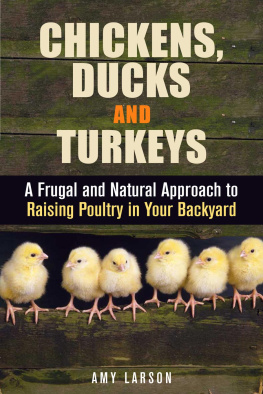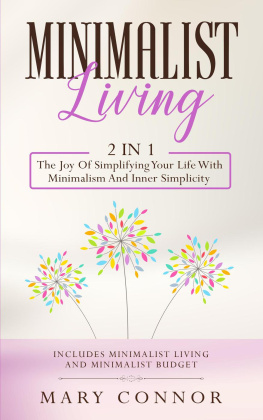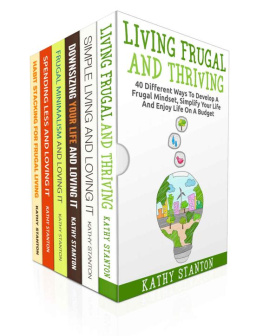Frugal Living Made Easy:
Live Better for Less without a Minimalist Approach!
Copyright Notice
Reproduction, duplication, transmission of this document in part or in whole is permitted only with written permission from the publisher. All rights reserved.
Respective brands and trademarks mentioned in this book belong to their respective owners.
Disclaimer
This document is geared towards providing summarization of information related to the topic. While all attempts have been made to verify the accuracy of the information, the author does not assume any responsibility for errors, omissions, or interpretations of the content. The information is offered for informational or entertainment purposes only. If professional advice is necessary, a qualified legal, medical, financial or another respective professional should be consulted. The reader is responsible for his or her own actions. The publisher does not accept any responsibility or liability arising from damages or losses, real or perceived, direct or indirect, resulting from the use of this information.
Table of Contents
Introduction
F rugal living and living on a budget has been all the rage over the past couple of years and whether you want to join in the savings from financial need or simply a desire to save, Frugal Living Made Easy is the perfect place to start. Unlike other extreme saving plans that focus on spending twenty three hours a day clipping coupons or buying nothing at all and growing it all yourself, this book focuses more on the everyday family with an everyday lifestyle. Not everyone is built for extreme saving even if they have an extreme need for financial savings, but the truth is that with the right tools in place, even smaller savings techniques can result in huge savings when implemented with consistency.
Frugal Living Made Easy is a book that focuses on frugal living as a family, but it also utilizes savings skills that everyone can implement to save money. The techniques outlined in this book focus on activities such as grocery shopping and food shopping as well as going out to eat, activities that all of us at one time or another incorporate in our lives whether as a family or alone. Rather than pushing you to become someone new by abandoning your current habits, this book focuses on how you can modify your current habits by including them in a more frugal lifestyle allowing you to save money while also still enjoying the things you love.
Chapter One: Bringing the Family on Board
O ne of the most important parts of making frugal living easy is beginning your journey as a cohesive unit - bring the entire family on board. If you have a family of four living at home, make sure everyone is on board with living a financially responsible life. If it's just you at home, make sure that you are committed to living a financially responsible life, because if you can't commit to making the small changes that will help you to live a frugal life then it's not the right time for you to begin trying.
A great way to bring the family on board with your new frugal living program is to call a family meeting. Make sure that during this meeting you make it clear to everyone WHY you are asking them to make these small changes, WHAT you are asking them to change and HOW they can help to make the new changes successful. It is also important to emphasize to every family member that the new changes that you are making are small changes that are not intended to deprive them of things they love because this is not what frugal living should be about. Emphasize that frugal living is not always about minimalist living!
In this chapter, you will learn:
- How to live frugally by making small sacrifices
- Living frugally successfully by working as a family
- Educating everyone in your family unit on cutting costs
Ask Everyone to Sacrifice Something
O ne of the first things that you can do to make everyone in your family feel like a valuable part of your frugal living project is to have each of them choose one thing to sacrifice. While frugal living is not about minimalist living and giving up everything, it is important to identify un-needed luxuries and cut them out of the family budget. Some examples of this type of sacrifice may include magazine subscriptions, fast food breakfast stops, coffee shop coffee and canteen lunches versus bag lunches. If each family member cuts one luxury item or un-needed expense from the family budget the total amount saved already adds up to a nice lump sum, but this is only the beginning of your simple frugal living strategy.
Asking each family member to sacrifice at least one superfluous item from their current lifestyle will soon result in a lump sum savings every month.
Ask Everyone to Pitch in and Help
H aving everyone in the family make a single sacrifice is a great way to begin monthly savings, but having everyone pitch in to continue saving helps to continue a frugal living lifestyle. Many times we rely on paid services for things that we are perfectly capable of doing for ourselves and this is a great opportunity for family members to pitch in and help to increase family savings. Living frugally means being able to give up gardening services and learning how to use a lawnmower, firing the maid and having the family clean up their own messes and no longer relying on a paper delivery boy to deliver a paper that you can pick up yourself once a week at the gas station. While most of these services are certainly considered to be "luxury" services to the average household, there are still plenty of other moderate services that we all pay for that can be taken care of by the family for a fraction of the cost.
Frugal living means stop paying others to do jobs that you can perform yourself for a fraction of the cost.
Educate Everyone on Cutting Costs
I n order to really maximize frugal living within your family unit it is important to educate everyone on the fact that there are cost cutting opportunities everywhere. A great example of this type of thinking includes younger family members who have very few demands financially can make an impact by taking shorter showers or taking showers instead of baths. Encourage family members to come up with other ways that they can help to cut costs around the house and keep a list on your refrigerator as a reminder. Some of our favorite ideas include: turning off lights when no one is in the room, replacing light bulbs with more efficient ones, replacing worn out appliances with energy efficient ones when possible, unplug items that are not in use, walk rather than drive, play outside rather than play with electronics, watch movies at home rather than at the movies and use blankets and fans rather than playing with the thermostat!
Frugal living can be encouraged by keeping a readily accessible list of easy ways that everyone in the family can cut costs.
Chapter Two: You Don't Have to Sacrifice It All
A common misconception about frugal living is that you have to live a minimalist lifestyle, sacrifice it all, to really save but this simply isn't true. You don't have to sacrifice it all to live a frugal life, in fact the sacrifices you already talked about are just about all the sacrifices we are going to cover in this book. We don't believe that living on a budget means living without the things that you love, life is too short for that so let's take a look at how you can live frugally without giving it all up.
In this chapter, you will learn:
- How you can make substitutions for things that you love
- How cutting coupons can work for you
- The importance of shopping circulars and sales
- Learning how to make things yourself
Next page














